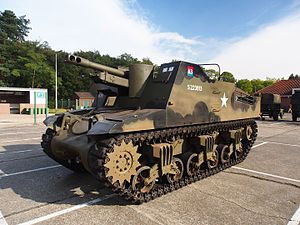Sexton (artillery)
| 25pdr SP, tracked, Sexton | |
|---|---|

A Sexton on display at the Dutch Cavalry Museum in 2013
|
|
| Type | Self-propelled artillery |
| Place of origin | Canada |
| Service history | |
| In service | 1943–1956 |
| Used by | Canada United Kingdom South Africa Poland Portugal |
| Wars | Second World War |
| Production history | |
| Designed | 1942 |
| Manufacturer | Montreal Locomotive Works |
| Produced | 1943–1945 |
| No. built | 2,000 |
| Variants | Mark I, Mark II |
| Specifications | |
| Weight | 25 tons (25.86 tonnes) |
| Length | 20 ft 1 in (6.12 m) |
| Width | 8 ft 11 in( 2.71 m) |
| Height | 8 ft (2.44 m) |
| Crew | 6 (Commander, Driver, Gunner, Gun-Layer, Loader, Wireless Operator) |
|
|
|
| Elevation | +40° to -9° |
| Traverse | 25° left 15° right1 |
|
|
|
| Armour | 15-32 mm |
|
Main
armament |
Ordnance QF 25 pounder (87.6 mm) Mk II 105 rounds (mostly HE) carried on board |
|
Secondary
armament |
Two 0.303 (7.7 mm) Bren light machine guns 50 30-round magazines |
| Engine |
Continental R-975 9 cylinder Radial gasoline 400 hp (298 kW) |
| Suspension | Vertical volute spring |
|
Operational
range |
125 miles+ (200 km) |
| Speed | 25 mph (40 km/h) |
The 25pdr SP, tracked, Sexton was a self-propelled artillery vehicle of the Second World War. It was based on Canadian-built versions of the American M3 Lee and M4 Sherman tank chassis, which entered production in Canada as the Ram and Grizzly. When Sherman production in the US expanded and supply was no longer a problem, in 1943 it was decided to switch the Canadian production lines to produce the Sexton to give the British Army a mobile artillery gun using their Ordnance QF 25 pounder gun-howitzer, which could fire an 87.6 mm (3.45 in) 11.5 kg (25 lb) HE shell or an armour-piercing shell. It found use in the Canadian and British Army, as well as numerous other British Empire and associated forces. Just after the war, a number of Grizzly and Sextons were sold to Portugal, who used them into the 1980s.
In order to better provide artillery support in the highly mobile desert warfare of the North African Campaign, the British Army had quickly adapted a number of obsolete Valentine tanks with the 25-pounder gun. These were introduced in 1942 as the Bishop, but proved to have many problems in service. In particular, the turret left little room for elevation, and gunners took to driving their tanks onto hills or dirt ramps in order to get the full range out of the gun. The Bishop was quickly replaced by the US-built M7 Priest, consisting of the US 105 mm gun mounted on the M3 Lee tank chassis.
However, the Priest used the American 105 mm howitzer rather than the British QF 25 pounder gun-howitzer. Having to supply different ammunition for just a few units complicated supply for the British Army. The US attempted to fit a 25 pounder to the M7 Priest, producing the T51 in mid-1942, but the program suffered delays including the destruction of the gun mount on the prototype during the first live-firing exercises. US resources were not available for a vehicle solely for British use, so Britain turned to Canada.
...
Wikipedia
